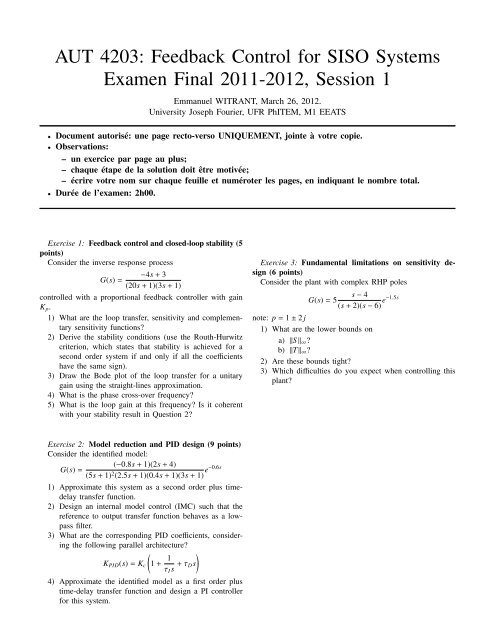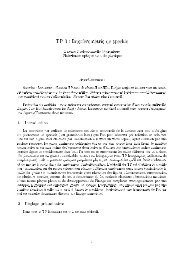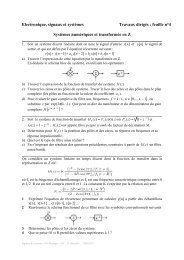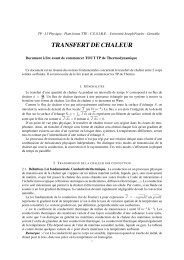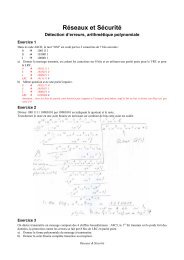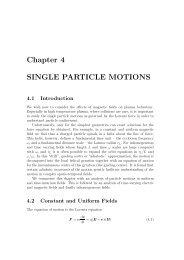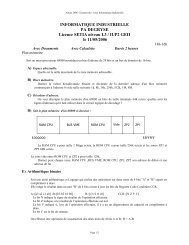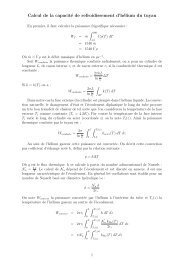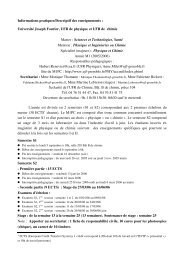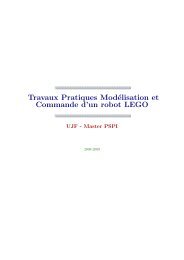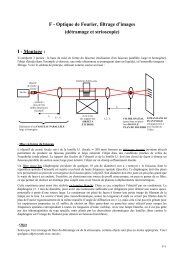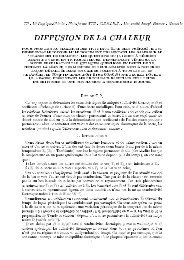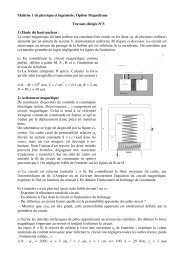AUT 4203: Feedback Control for SISO Systems Examen Final 2011 ...
AUT 4203: Feedback Control for SISO Systems Examen Final 2011 ...
AUT 4203: Feedback Control for SISO Systems Examen Final 2011 ...
Create successful ePaper yourself
Turn your PDF publications into a flip-book with our unique Google optimized e-Paper software.
<strong>AUT</strong> <strong>4203</strong>: <strong>Feedback</strong> <strong>Control</strong> <strong>for</strong> <strong>SISO</strong> <strong>Systems</strong><strong>Examen</strong> <strong>Final</strong> <strong>2011</strong>-2012, Session 1Emmanuel WITRANT, March 26, 2012.University Joseph Fourier, UFR PhITEM, M1 EEATS• Document autorisé: une page recto-verso UNIQUEMENT, jointe à votre copie.• Observations:– un exercice par page au plus;– chaque étape de la solution doit être motivée;– écrire votre nom sur chaque feuille et numéroter les pages, en indiquant le nombre total.• Durée de l’examen: 2h00.Exercise 1: <strong>Feedback</strong> control and closed-loop stability (5points)Consider the inverse response processG(s) =−4s + 3(20s + 1)(3s + 1)controlled with a proportional feedback controller with gainK p .1) What are the loop transfer, sensitivity and complementarysensitivity functions?2) Derive the stability conditions (use the Routh-Hurwitzcriterion, which states that stability is achieved <strong>for</strong> asecond order system if and only if all the coefficientshave the same sign).3) Draw the Bode plot of the loop transfer <strong>for</strong> a unitarygain using the straight-lines approximation.4) What is the phase cross-over frequency?5) What is the loop gain at this frequency? Is it coherentwith your stability result in Question 2?Exercise 3: Fundamental limitations on sensitivity design(6 points)Consider the plant with complex RHP poless − 4G(s) = 5(s + 2)(s − 6) e−1.5snote: p = 1 ± 2 j1) What are the lower bounds ona) ||S || ∞ ?b) ||T|| ∞ ?2) Are these bounds tight?3) Which difficulties do you expect when controlling thisplant?Exercise 2: Model reduction and PID design (9 points)Consider the identified model:(−0.8s + 1)(2s + 4)G(s) =(5s + 1) 2 (2.5s + 1)(0.4s + 1)(3s + 1) e−0.6s1) Approximate this system as a second order plus timedelaytransfer function.2) Design an internal model control (IMC) such that thereference to output transfer function behaves as a lowpassfilter.3) What are the corresponding PID coefficients, consideringthe following parallel architecture?(K PID (s) = K c 1 + 1 )τ I s + τ Ds4) Approximate the identified model as a first order plustime-delay transfer function and design a PI controller<strong>for</strong> this system.
2Related class materialA. On model reduction and IMC||w P S || ∞ ≥ M zpi |w P (z j )|, M zpi =i=1– <strong>for</strong> each RHP-pole p ii.e.∏N p|z j + ¯p i |||S || ∞ = M s ≥|zi=1 j − p i |– 1 st order G(s) = e −θs /(τs + 1) obtained fromτ 1 = τ 1o + τ 2o2 , θ = θ o + τ ∑ ∑2o2 + τ io + T invjo + h 2i≥3 jwhere h is the sampling period (if digital implementation)– 2 nd order G(s) = e −θs /(τ 1 s+1)(τ 2 s+1) obtained fromτ 1 = τ 1o , τ 2 = τ 2o + τ 3o2 , θ = θ o+ τ ∑ ∑3o2 + τ io + T invjo +h 2i≥4 jG(s) = G m G aG a (s) = e −θs ∏ i −s+z is+z i, R(z i ) > 0, θ > 02) specify desired T (r → y) including G a1T(s) = f (s)G a (s), f (s) = (LP filter)(τ c s + 1)n3) from T = GK(1 + GK) −1 , the controller isK = G −1 T1 − T = 1G−1 mf −1 − G a||w T T|| ∞ ≥ |w T (p)| <strong>for</strong> CL stability– <strong>for</strong> each RHP-zero z jModel reduction and effective delay• Simple rules to get to previous 1 st − 2 nd order descriptionfrom “effective delay” approximations e −θs ≈ 1−θs (RHPz→ θ) & e −θs ≈ 1/(1 + θs) (lag → θ, conservative)• Half rule: the largest selected lag (den) time cst isdistributed equally to the effective delay and the smallestretained time cst– original model (τ 1o > τ io > τ np o and T invjo = 1/z jo > 0)∏j(−T invjoG o (s) = ∏s + 1)e −θ osi(τ io s + 1)IMC [Morari & Zafiriou’89]• Successful in many applications: specify desired CL andsolve <strong>for</strong> K(s) - Pole placement analogy• Inverse-based control design:1) factorize into invertible minimum-phase G m andnon-invertible all-pass G a (RHP-z & θ)⇒ invert min phase part of GB. On sensitivity peaksProvide explicit bounds on weighted peaks of S :• Bound on weighted sensitivity <strong>for</strong> plant with RHP-zeroz, with w P (s) any stable weight function:||w P S || ∞ ≥ |w P (z)| <strong>for</strong> CL stability• Bound on weighted complementary sensitivity <strong>for</strong> plantwith RHP-pole p, with w T (s) any stable weight function:• Bounds <strong>for</strong> plant with N z RHP-zeros z j and N p RHP-polesp i , then CL stability if∏N p||w T T|| ∞ ≥ M pzi |e p iθ ||w T (p i )|, M pzi |e p iθ | =|z j + ¯p i ||z j − p i | ≥ 1∏N z• M zpi and M pzi provide M S and M T taking w P = w T = 1,• The bounds are tight (a K achieves them) if– single real RHP-z and no θ: min K ||S || ∞ = M S,min =M T,min = M zpi– single RHP-p: min K ||T|| ∞ = M T,min = M pzi |e pθ |, &||S || ∞ ≥ ||T|| ∞ − 1– single RHP-p and no θ: min K ||T|| ∞ = M T,min =M S,min• Sensitivity shaping limitations:– S limited by RHP-z– T limited by RHP-p– emphasized if multiple RHP-p/z, large peaks if close• Stabilization: difficult (impossible) if RHP-z and RHP-pare close (|z − p| small)i= j|¯z j + p i ||z j − p i | |ep iθ | ≥ 1


